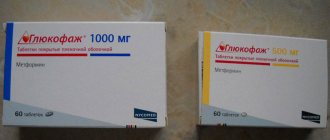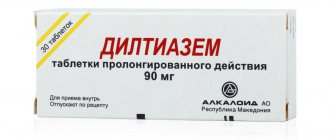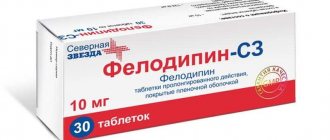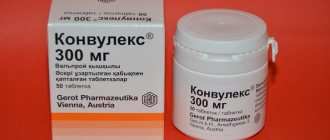pharmachologic effect
A purine derivative, it is a phosphodiesterase inhibitor.
The principle of action is based on blocking specific purine receptors, stimulating the accumulation of cAMP in tissue depots, reducing the contractility of smooth muscle tissue, and reducing the volume of calcium ions passing through cell membranes.
The drug has a vasodilating effect , which manifests itself in peripherally located vessels. The active substance increases blood flow in the renal system, relaxes the smooth muscle system of the bronchi and blood vessels.
Characterized by a moderately expressed diuretic, diuretic effect . The medication prevents the release and release of mediators of allergic responses , stabilizes the cell membrane of mast cells . In case of hypokalemia, the active component enhances pulmonary ventilation.
The medication normalizes the functioning of the respiratory system, ensuring complete saturation of the blood with oxygen, while simultaneously reducing the level of carbon dioxide. Stimulation of the respiratory center was recorded. The drug stimulates and enhances the contractility of the diaphragm, increases mucociliary clearance, and improves the functioning of the intercostal and respiratory muscles.
The active substance normalizes microcirculation, reduces thrombus formation, prevents the aggregation of platelet cells by suppressing a specific factor, improves rheological parameters of the blood, and increases the resistance of red to deformation.
The drug reduces overall pressure in the pulmonary circulation, reduces vascular resistance in the pulmonary system, and reduces vascular tone of the skin, brain and kidneys.
The medication increases coronary blood flow, stimulates heart function, increases the need of myocardial cells for oxygen, increases heart rate and increases the force of heart contractions.
Pharmacodynamics and pharmacokinetics
After oral administration, the active substance is completely absorbed from the lumen of the digestive tract. Food intake may affect the clearance of theophylline and the rate of absorption, but not the extent. 40% bound to plasma proteins. Metabolism occurs in the hepatic system with the participation of cytochrome P450 isoenzymes.
Active metabolites are excreted through the renal system, 10% are excreted unchanged, in their original form. Metabolic rates are influenced by factors such as smoking , age, diet, concurrent drug therapy, and concomitant pathology. With COPD, pulmonary edema, chronic alcoholism , pathology of the hepatic system, heart failure, a decrease in clearance is recorded.
Indications for use (what Teopek tablets are for)
Bronchoobstruction of various origins:
- emphysema ;
- chronic obstructive bronchitis;
- bronchial asthma;
- sleep apnea;
- pulmonary heart;
- pulmonary hypertension.
Teopek 300 mg can be used in the treatment of edema syndrome of renal origin (together with other medications).
Release form and composition
Teopek is available in the form of prolonged-release tablets: white, biconvex, scored (for 300 mg tablets), sometimes with a slight specific odor [10 pcs. in blister packs, 5 packs in a cardboard pack; 50 pcs. (tablets 100 mg and 200 mg) or 40 pcs. (300 mg tablets) in plastic jars, 1 jar in a cardboard box].
Composition per 1 tablet of prolonged action:
- active ingredient: theophylline – 100 mg, 200 mg or 300 mg;
- auxiliary components: calcium stearate, interpolymer complex of polyethylene glycol (macrogol) and polymethacrylic acid.
Contraindications
- hemorrhagic stroke;
- peptic ulcer of the digestive tract;
- epilepsy;
- severe forms of tachyarrhythmias;
- a history of bleeding from the digestive system;
- individual hypersensitivity;
- arterial hypotension and hypertension ;
- gastritis with high acidity of gastric juice ;
- age restrictions – up to 12 years.
Directions for use and doses
Teopek is taken orally 30-60 minutes before meals or 2 hours after meals, with a sufficient amount of water. The tablet can be split in half, but must not be crushed, chewed, or dissolved in water. In some cases, to reduce the irritant effect on the gastric mucosa, the drug should be taken during or immediately after meals.
The dosage regimen should be set individually, depending on the patient’s age, body weight and metabolic characteristics.
The initial daily dose for adults and children over 12 years of age weighing more than 45 kg is 300 mg (1 tablet once a day). After 3 days of taking the drug, the daily dose can be increased to 450 mg (1½ tablets), after another 3 days of treatment, if necessary, the daily dose can be increased to 600 mg (1 tablet 2 times a day). Increasing doses is possible only if well tolerated.
For children from 6 to 12 years old with a body weight of 20-45 kg, the daily dose is 150 mg (½ tablet once a day). After 3 days of taking the drug, increase the daily dose to 300 mg (½ tablet 2 times a day), after another 3 days of treatment, the daily dose can be increased to 450-600 mg (1½ tablet 1 time per day or 1 tablet 2 times per day).
Patients with central sleep apnea syndrome can take a single dose of Teopek at night.
Further increases in doses are recommended based on determining the concentration of theophylline in the blood serum.
For patients who smoke, the daily dose can be gradually increased to 900-1050 mg (3-3½ tablets).
Children.
The drug is not used for children under 6 years of age weighing less than 20 kg.
Side effects
Nervous system:
- insomnia;
- limb tremors;
- irritability;
- headache;
- dizziness;
- nervous overexcitation;
- increased anxiety.
The cardiovascular system:
- cardialgia;
- drop in blood pressure ;
- a feeling of interruptions in the work of the heart;
- cardiopalmus;
- increased frequency of angina attacks;
- arrhythmias.
Digestive tract:
- decreased appetite;
- gastralgia;
- gastroesophageal reflux;
- nausea;
- exacerbation of gastrointestinal ulcer;
- heartburn;
- vomit;
- diarrhea syndrome.
Other reactions:
- tachypnea;
- sensation of blood flow to the face;
- chest pain;
- allergic responses;
- fever;
- itchy skin;
- increased sweating;
- increased diuresis;
- hematuria;
- albuminuria;
- hypoglycemia.
When the dose is reduced, there is a decrease in the severity of negative reactions.
Use during pregnancy or breastfeeding
Theophylline crosses the placenta and into breast milk. The use of Teopek during pregnancy is possible only if the expected benefit to the mother outweighs the potential risk to the fetus. In pregnant women, serum theophylline concentrations should be determined more frequently and the dose adjusted accordingly. Theophylline should be avoided at the end of pregnancy because it can suppress uterine contractions and cause tachycardia in the fetus.
If it is necessary to use the drug for women who are breastfeeding, it is recommended to stop breastfeeding.
Instructions for use of Teopek (Method and dosage)
The treatment regimen is selected individually. The average initial daily dosage is 400 mg. It is possible to increase the dose by 25% every 2-3 days if Teopek is well tolerated (calculation is based on the initial dose).
The maximum amount of medication that does not require mandatory monitoring of the level of theophylline in the blood is 900 mg/day.
Instructions for use of Teopek require monitoring the level of the active substance in the blood if any signs of intoxication occur. Optimal dosages vary in the range of 10-20 mcg/ml.
Increasing the indicated dose does not provide a significant increase in the effect, but provokes an increase in the severity of negative reactions. When the dose is reduced, a weakening of the therapeutic effect is recorded.
Application Features
Teopek should be used with caution, and only if absolutely necessary, in unstable angina, heart disease in which tachyarrhythmia may be observed, hypertrophic obstructive cardiomyopathy, impaired renal and liver function, patients with a history of peptic ulcer disease and patients over 60 years of age.
The use of theophylline in cases of severe vascular atherosclerosis and sepsis is possible with caution under the supervision of a physician, if there are indications for the use of theophylline. Restrictions on the use of theophylline for gastroesophageal reflux are associated with the effect on the smooth muscles of the cardioesophageal sphincter, which can worsen the patient's condition with gastroesophageal reflux, increasing reflux.
Monitoring is necessary when treating patients with cardiac arrhythmia, arterial hypertension, other cardiovascular diseases, and acute febrile conditions with theophylline.
During treatment with theophylline, it is necessary to carefully monitor and reduce the dose in the treatment of patients with heart failure, chronic alcoholism, impaired liver function (especially cirrhosis), with a reduced concentration of oxygen in the blood (hypoxemia), with elevated body temperature, with pneumonia or with viral infections. infections (especially influenza) due to a possible decrease in the clearance of theophylline. At the same time, it is necessary to monitor plasma theophylline levels.
Patients with a history of seizures should avoid theophylline and use alternative treatment.
Increased attention is required when using the drug in patients suffering from insomnia, as well as in elderly men with a history of prostate enlargement due to the risk of urinary retention.
If the use of aminophylline (theophylline-ethylenediamine) is necessary in patients who have already taken Teopec, it is necessary to continue to monitor plasma theophylline levels.
Because bioequivalence between individual extended-release theophylline-containing products cannot be guaranteed, switching from therapy with Theopec extended-release tablets to another extended-release xanthine product should be made through repeated dose titration and clinical evaluation.
Tobacco smoking and alcohol consumption can lead to an increase in the clearance of theophylline and, accordingly, to a decrease in its therapeutic effect and the need for higher doses.
Theophylline can change some laboratory parameters: increase the amount of fatty acids and the level of catecholamines in the urine.
If the effect of the recommended dose is insufficient and if side effects occur, the concentration of theophylline in the blood plasma should be determined.
Fever reduces the clearance of theophylline. In case of acute fever, it may be necessary to reduce the dose of the drug to avoid intoxication.
Theophylline is not the drug of choice for children with bronchial asthma.
Overdose
- ventricular forms of arrhythmias;
- diarrhea;
- decreased appetite;
- bleeding from the gastrointestinal tract;
- insomnia;
- tachycardia;
- hyperemia of the skin;
- tachypnea;
- convulsions;
- vomiting blood;
- tremor;
- photophobia;
- anxiety;
- hyperarousal.
Severe poisoning manifests itself:
- drop in blood pressure;
- development of epileptoid seizures;
- confusion;
- hypokalemia;
- hyperglycemia;
- metabolic acidosis;
- renal failure with myoglobinuria.
Gastric lavage, taking enterosorbents , laxatives, forced diuresis, hemodialysis , plasma sorption, hemosorption are effective.
When seizures occur, oxygen therapy and intravenous administration of Diazepam are recommended to relieve the seizure. For vomiting and severe nausea, Ondansetron and Metoclopramide are prescribed intravenously.
Interaction
Macrolide antibiotics , Cimetidine , Allopurinol, Lincomycin, isoprenaline and oral contraceptives can reduce the clearance rate of the active substance theophylline.
A decrease in the effectiveness of beta-blockers , a narrowing of the bronchial lumen, and a decrease in the severity of the bronchodilator effect of Teopek have been recorded. The above-described effects are more pronounced in non-selective forms of beta-blockers compared to selective ones.
Theophylline activity increases with treatment with Furosemide , beta2-adrenergic receptor stimulants, and Caffeine . With the use of Aminoglutethimide, increased removal of Theophylline from the body and loss of its effectiveness are recorded.
Acyclovir increases the severity of negative reactions of the drug due to its ability to increase the level of the active substance in the blood.
Nifedipine , Diltiazem , Verapamil and Felodipine do not change the severity of the bronchodilator effect of the drug, but can change its concentration in plasma. The medical literature describes cases of increased negative reactions of the drug and an increase in the level of the active substance in the blood during simultaneous therapy with Nifedipine and Verapamil.
Disulfiram is capable of increasing the level of Theophylline in the blood to critical, toxic levels. Propranolol reduces the clearance of the active substance. Li salts lose their effectiveness when treated with Teopek. The concentration of the active substance increases with simultaneous therapy with fluoroquinolones and Enoxacin .
An increase in the clearance of Theophylline and a decrease in the intensity of its effects are recorded during treatment with Isoniazid, Phenobarbital, Sulfinpyrazone, Carbamazepine, Rifampicin . A mutual decrease in concentration is observed with the simultaneous use of Phenytoin and Theophylline.
Interaction with other drugs and other types of interactions
Drugs that increase the clearance of theophylline: aminoglutemide, antiepileptic drugs (eg, phenytoin, carbamazepine, primidone), isoproterenol, magnesium hydroxide, moracizine, rifampicin, ritonavir, sulfinpyrazone, barbiturates (especially phenobarbital and pentobarbital). In patients taking one or more of the above drugs concomitantly with theophylline, monitor serum theophylline concentrations and increase the dose if necessary.
Drugs that reduce theophylline clearance: allopurinol, acyclovir, carbimazole, phenylbutazone, imipenem, calcium channel blockers, cimetidine, fluconazole, furosemide, pentoxifylline, disulfiram, interferon, nizatidine, calcium antagonists (verapamil, diltiazem), amiodarone, paracetamol, probenecid, ranitidine , tacrine, propafenone, propranolol, oxpentiphylline, isoniazid, lincomycin, methotrexate, zafirlukast, mexiletine, fluoroquinolones (ofloxacin, norfloxacin, when using ciprofloxacin it is necessary to reduce the dose by at least 60%, enoxacin - by 30%), macrolides (clarithromycin, erythromycin), ticlopidine, thiabendazole, viloxazine hydrochloride, oral contraceptives, influenza vaccine, and herbal preparations that contain St. John's wort (Hypericum perforatum). Patients who are taking one or more of the above drugs in parallel with theophylline should monitor serum theophylline concentrations and reduce the dose if necessary.
Combinations of theophylline and benzodiazepine, halothane and lomustine should be used with extreme caution. Halothane anesthesia can cause serious cardiac arrhythmias in patients taking theophylline.
The simultaneous use of Teopek and large amounts of food and drinks containing methylxanthines (coffee, tea, cocoa, chocolate, Coca-Cola and similar tonic drinks), medications containing xanthine derivatives (caffeine, theobromine, pentoxifylline), α- and β-adrenergic agonists (selective and non-selective) and glucagon, given the potentiation of the effects of theophylline.
Concomitant use of theophylline with beta-blockers may antagonize its bronchodilator effect; with ketamine, quinolones – reduces the seizure threshold; with adenosine, carbonate and β-receptor antagonists - the effectiveness of the latter decreases; with doxapram – may cause stimulation of the central nervous system.
Theophylline may enhance the effect of diuretics and reserpine; reduce the effectiveness of adenosine, lithium carbonate and β-receptor antagonists.
There is conflicting evidence for potentiation of theophylline's effects in influenza conditions.
Xanthines may potentiate hypokalemia caused by therapy with β2-agonists, steroids, diuretics and hypoxia. This is especially true for hospitalized patients with severe asthma who need to monitor serum potassium levels.
The combination of theophylline and fluvoxamine should be avoided. If this combination is unavoidable, patients should be prescribed half the dose of theophylline and plasma concentrations of the latter should be monitored.
special instructions
With severe coronary insufficiency ( angina pectoris, myocardial infarction in the acute period), ventricular extrasystole , total vascular atherosclerosis , obstructive hypertrophic cardiomyopathy , peptic ulcer of the digestive tract, chronic heart failure, severe pathology of the hepatic system, increased convulsive activity, prostate hypertrophy, gastroesophageal reflux, pregnancy , thyrotoxicosis , uncontrolled hypothyroidism (cumulation is recorded), the medication is used with caution.
In pediatric practice and elderly patients, Teopek can be prescribed for health reasons.
Rectal forms are used with caution in cases of diagnosed diseases of the direct intestine (and if they are suspected), and in case of diarrhea syndrome . In smoking patients, there is a decrease in the effectiveness of the medication.
Simultaneous therapy with other drugs whose active ingredients are xanthine derivatives is unacceptable. In elderly patients with severe concomitant pathology, with viral infectious lesions, with diseases of the hepatic and cardiovascular systems, correction of the treatment regimen is required.
Contraindications to the use of Teopek
There are a number of natural conditions and pathologies of the body that prohibit the use of Teopek tablets.
The effect of the drug should be limited in the following diseases:
- Acute myocardial infarction;
- Brain stroke;
- Significant increase or decrease in blood pressure;
- Vascular atherosclerosis with cholesterol deposition;
- Violation of heart rhythm and heart rate;
- Epilepsy with frequent seizures;
- Gastritis with increased acidity levels;
- Relapse of peptic ulcer;
- Overactive thyroid gland;
- Increased convulsive activity of the cerebral cortex with seizures;
- Individual hypersensitivity to theophylline or other components of the drug;
- Pregnancy and lactation;
- Age less than 3 years.
The drug is prescribed with caution in cases of insufficient heart function, decreased performance of the kidneys and liver, reflux esophagitis, prolonged high temperature of unknown origin, hypertrophic enlargement of the prostate gland in males, recent bleeding from the gastrointestinal tract.
The prescription and dosage of Teopek tablets is carried out by a bronchopulmonologist or therapist, taking into account the effect of the drug on concomitant chronic diseases.
Analogs
Level 4 ATC code matches:
Aerophyllin
Eufillin
Theotard
Theophylline
Aminophylline
Neophylline
- Theotard;
- Teofedrine-N;
- Eufillin.




